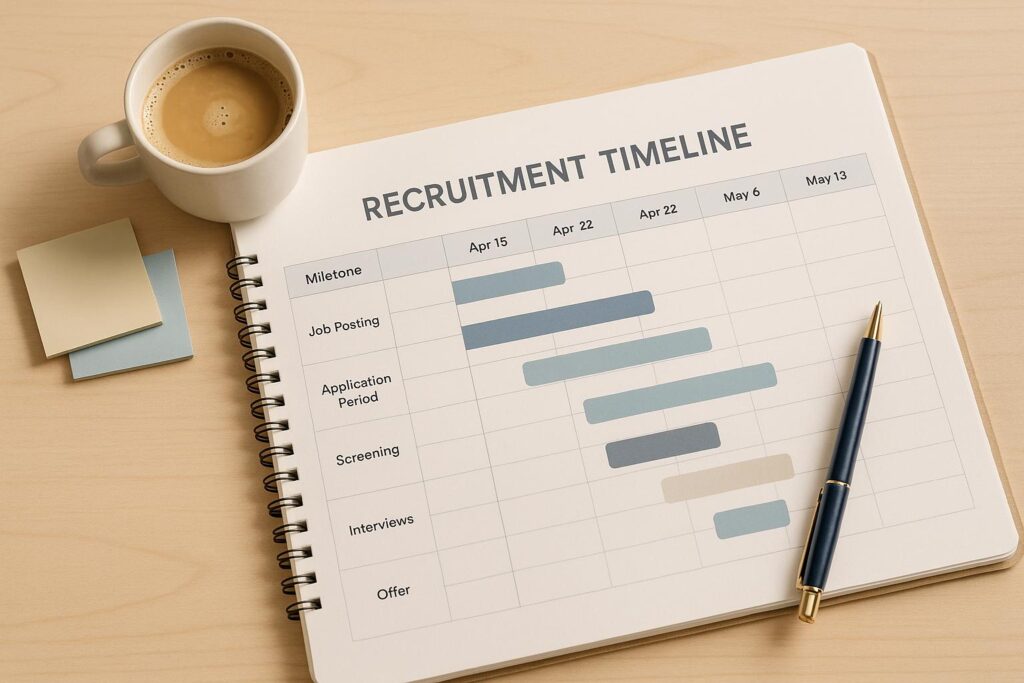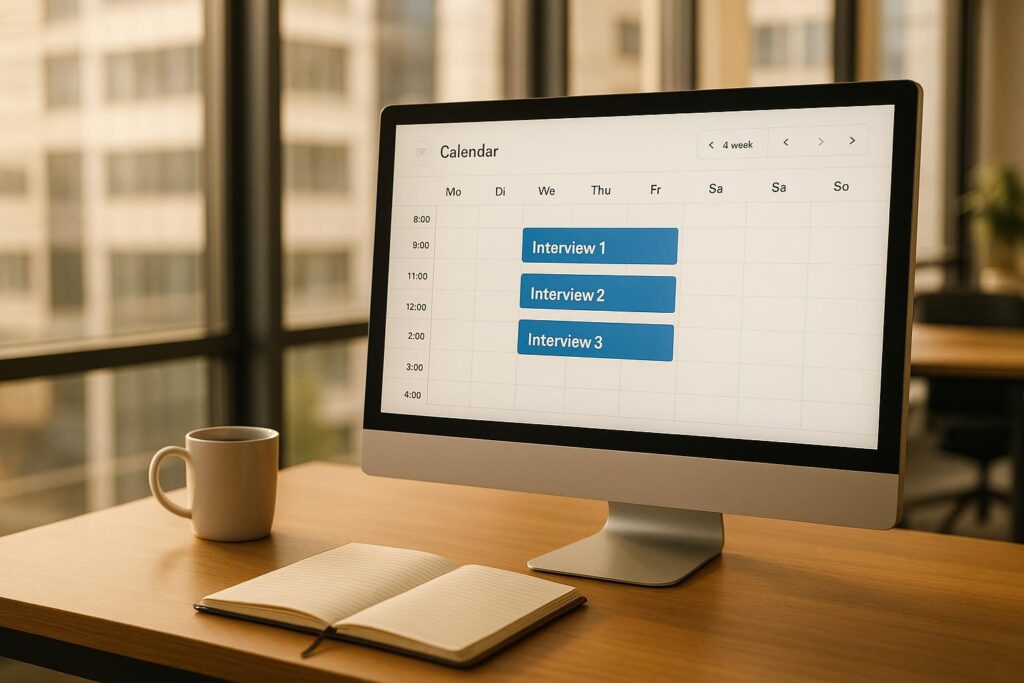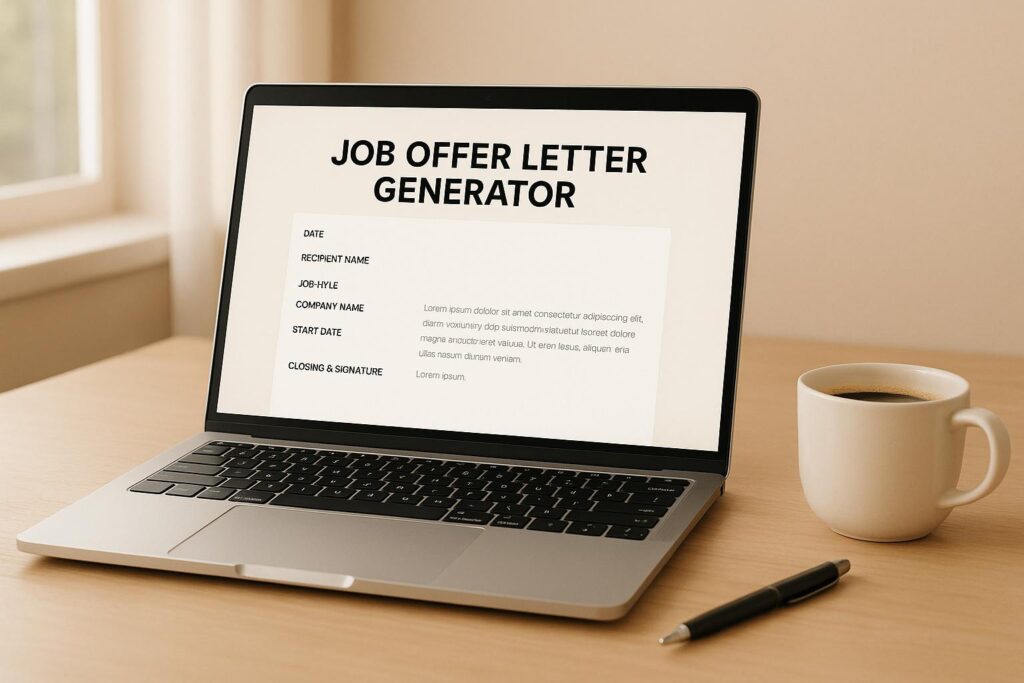Hiring delays can cost you top candidates, increase expenses, and strain your team. But with the right tools and strategies, you can cut your hiring time by up to 70% without sacrificing quality. Here’s how:
- Use an ATS: Simplify job postings, resume parsing, and interview scheduling with an all-in-one platform.
- Automate Resume Screening: AI tools rank candidates instantly, saving hours on manual reviews.
- Automate Scheduling: Tools eliminate back-and-forth emails, reducing coordination time by up to 36%.
- Automate Communication: Keep candidates engaged with automated updates and reminders.
- Build a Job Portal: Centralize job listings and applications for a smoother experience.
- Leverage Social Media: Reach passive candidates and fill roles faster with AI-powered sourcing.
- Track Referrals Digitally: Streamline employee referrals with automated tracking and updates.
- Use Automated Assessments: Evaluate skills efficiently with AI-scored tests and video interviews.
- Apply Recruitment Analytics: Use data to identify bottlenecks and improve hiring decisions.
- Ensure Data Security: Protect candidate information and stay compliant with regulations.
These methods not only save time but also improve the hiring experience for both recruiters and candidates. Start by identifying your biggest bottlenecks and gradually implement automation tools to optimize your process.
How to Speed Up Your Hiring Process Without Sacrificing Candidate Quality
1. Use an Applicant Tracking System (ATS)
An Applicant Tracking System (ATS) acts as the backbone of your recruitment process, replacing the chaos of spreadsheets and endless email chains with a single, organized platform. With an ATS, tasks like posting jobs, managing applications, scheduling interviews, and collaborating with your hiring team become streamlined and efficient. It’s a game-changer for reducing the delays often caused by manual processes.
By 2025, around 78% of companies are expected to use AI to automate parts of their hiring workflow. This shift isn’t just about convenience – it’s about staying competitive in a fast-moving hiring landscape. An ATS not only simplifies recruitment but also sets the stage for smarter, technology-driven hiring practices.
Time-Saving Capabilities
One of the standout features of an ATS is its ability to cut down on repetitive tasks that eat up recruiters’ time. These systems can automatically post job listings to multiple platforms, parse resumes, and send out emails or notifications – all without manual intervention.
On average, recruiters save 15–20 hours per week by automating tasks like resume collection and interview scheduling. Beyond just saving time, ATS platforms can shorten hiring cycles by up to 60% and reduce time-to-hire by as much as 70%. This efficiency ensures candidates move quickly and smoothly through the recruitment pipeline.
Automation Features
Modern ATS platforms go beyond basic functionality, offering AI-powered tools that act like virtual recruitment assistants. These systems can generate ranked shortlists of candidates, summarize applications, and even provide automated scoring for video interviews.
With features like AI-driven insights, automated outreach, and intelligent screening, recruiters can quickly identify the best-fit candidates. By handling preliminary evaluations, these tools ensure only the most qualified individuals progress to the next stages, saving time and improving decision-making.
Integration with Existing Systems
A well-designed ATS doesn’t operate in isolation – it integrates seamlessly with tools you’re already using. From payroll systems and job boards to social media platforms and assessment tools, an ATS centralizes all recruitment activities.
For example, when integrated with professional networks, an ATS can source candidates more efficiently. It can also sync with HR systems for onboarding and calendar tools for scheduling, eliminating the need for manual data transfers. This creates a cohesive recruitment ecosystem where every tool works together, ensuring a smooth flow of information from sourcing to hiring.
Impact on Candidate Experience
While ATS platforms are a huge asset for recruiters, they also play a key role in improving the candidate experience. Features like mobile-friendly application portals, automated status updates, and streamlined scheduling keep candidates informed and engaged throughout the process.
Some ATS solutions achieve over 90% completion rates for candidate screenings. When applying is easy, progress is clear, and scheduling is hassle-free, candidates are more likely to stay engaged. Additionally, timely communication and clear next steps reflect positively on your employer brand. Even when recruiters are busy, automated updates ensure candidates feel valued and informed, leaving a lasting impression.
2. Automate Resume Screening and Candidate Selection
Manually sifting through resumes can be a huge drain on time and resources. With AI-powered tools, recruiters can now automate the process, quickly analyzing, ranking, and filtering candidates based on specific criteria. This allows hiring teams to focus their energy on evaluating the most promising applicants.
These tools do much more than just match keywords. Today’s automation technology can parse resumes to extract critical details – like technical skills, work experience, education, and career growth – making the screening process faster and more precise.
Time-Saving Capabilities
Automated resume screening slashes the time spent on evaluations. By instantly ranking candidates based on qualifications and flagging potential concerns, these systems let recruiters zero in on the best-fit candidates without delay.
Automation Features
Advanced tools go beyond the basics by combining AI-driven data parsing with compatibility scoring. These systems assess skills, experience, and qualifications to determine how well a candidate aligns with the job requirements. They can even spot transferable skills and patterns that might indicate a candidate’s potential for success.
Predictive analytics take it a step further, evaluating not only a candidate’s current qualifications but also their likelihood of excelling in the role over time. Many tools also include features designed to minimize bias, focusing purely on job-relevant factors. This helps promote diversity and inclusion throughout the hiring process.
Integration with Existing Systems
Modern automation tools integrate seamlessly with Applicant Tracking Systems (ATS), funneling pre-screened candidates directly into the recruitment pipeline. They also connect with assessment platforms and scheduling tools, automating everything from skills tests to interview scheduling.
For example, candidates who pass the initial screening can be invited to complete additional evaluations, such as technical tests or personality assessments. Integration with calendar and communication tools further streamlines the process, automating interview scheduling and sending personalized follow-up messages. These features ensure a smooth, efficient workflow at every stage of recruitment.
Impact on Candidate Experience
Automation doesn’t just make life easier for recruiters – it also improves the experience for candidates. Faster response times mean applicants get timely updates on their status. In fact, 46% of candidates lose interest if they don’t hear back within one to two weeks.
Additionally, automated systems can provide tailored feedback to those who aren’t selected, helping to preserve a positive impression of the company. This kind of thoughtful communication enhances employer branding, even when delivering disappointing news, and aligns with the broader automation strategies discussed in upcoming sections.
3. Streamline Interview Scheduling with Automated Tools
Coordinating interviews across multiple participants, accommodating candidate preferences, and juggling time zones can make scheduling a logistical nightmare. Automated scheduling tools simplify this process by syncing with calendars, sending reminders, and allowing candidates to choose from available time slots. The result? A smoother experience for everyone involved.
But these tools go beyond just setting appointments – they handle the entire coordination process. Let’s break down how they save time and improve efficiency.
Time-Saving Capabilities
Recruiters spend a significant amount of their time – around 30% – on administrative tasks like scheduling. Automated tools can cut this time dramatically. For example, General Motors used Paradox’s conversational AI assistant to reduce interview scheduling from five days to just 29 minutes. Businesses, on average, report saving up to 36% of the time typically spent on scheduling. This allows recruiters to focus more on candidate evaluation and less on managing calendars.
Automation Features
These tools come packed with features designed to simplify scheduling. AI-powered systems identify open time slots, align with candidate preferences, and ensure there are no scheduling conflicts. They also automatically adjust for time zones, making global hiring a breeze. Look for key features like:
- Calendar integration for real-time availability
- Automated reminders to reduce no-shows
- Customizable workflows for tailored processes
- Candidate self-scheduling for added flexibility
Many tools also offer multilingual support and handle global scheduling seamlessly. With built-in templates for confirmations and reminders, communication stays consistent and professional.
Integration with Existing Systems
Integration with existing platforms like ATS (Applicant Tracking Systems) and HRIS (Human Resource Information Systems) takes automation to the next level. For instance, once a candidate clears initial screening, the system can automatically send out interview invitations. Real-time calendar syncing ensures no double-bookings and keeps everyone informed of changes.
Some advanced systems, like GoodTime’s AI, even analyze scheduling workflows to pinpoint bottlenecks and inefficiencies. This helps teams refine their processes and address delays, ensuring continuous improvement.
Impact on Candidate Experience
Streamlined scheduling doesn’t just benefit recruiters – it significantly improves the candidate experience too. When candidates can easily schedule interviews and receive instant confirmations, it leaves a positive impression. Considering that over 50% of scheduled interviews require rescheduling, automated tools step in to quickly adjust and notify all parties involved. This kind of efficiency makes the entire process feel seamless and professional.
4. Set Up Automated Candidate Communication
Once scheduling is streamlined, the next step is keeping candidates in the loop throughout the hiring process. This doesn’t mean you need to send every update manually. Automated communication tools can handle repetitive messaging tasks, ensuring candidates stay informed while allowing your team to focus on more meaningful interactions. It’s a smart way to manage candidate relationships on a larger scale.
Time-Saving Benefits
Recruiters can save 15–20 hours per week by automating routine communication tasks like follow-ups and status updates. Instead of spending time crafting individual messages, recruiters can rely on automation to handle interview confirmations, rejection letters, and progress updates. This freed-up time can then be used to focus on deeper, strategic engagement with candidates.
Advanced Automation Features
Today’s automation tools are far more sophisticated than simple email templates. They can send personalized, stage-specific messages, deliver interview reminders to reduce no-shows, and provide status updates to keep candidates informed. Some platforms even include chatbot-driven FAQs that offer instant answers to common questions. Centralized inboxes ensure all candidate communications are organized and consistent, while customizable templates and scheduling triggers create a communication flow that feels personal, even though it’s automated. These features work together to ensure seamless messaging and data sharing across the entire recruitment process.
Seamless System Integration
Modern communication tools are designed to integrate smoothly with existing systems like applicant tracking systems (ATS), HR information systems, and calendar tools . This integration allows candidate data to move effortlessly between platforms, reducing manual input and minimizing errors. As candidates progress through different hiring stages, automated triggers can send the appropriate messages. Plus, unified communication records make it easy to track what’s been sent, ensuring a consistent and efficient recruitment workflow.
Enhancing the Candidate Experience
Prompt updates and clear next steps can significantly improve the candidate experience, reducing the uncertainty and stress that often come with job applications. However, it’s important not to over-automate, as excessive automation might feel impersonal. Striking the right balance ensures candidates feel valued and engaged. When paired with tools for scheduling and screening, automated communication becomes a key component of a streamlined and effective hiring strategy. Regular, transparent updates keep candidates engaged and set the tone for a positive hiring journey.
5. Build Job Portals for Wider Candidate Reach
Creating a dedicated job portal can significantly expand your talent pool while giving you complete control over the candidate experience from the moment they engage with your brand. This direct approach allows potential hires to explore opportunities effortlessly and provides a clear, streamlined path for qualified individuals to apply for your open roles.
When paired with your Applicant Tracking System (ATS) and automated workflows, a customized job portal becomes a powerful addition to your recruitment strategy. It simplifies listing management by automating job postings and syncing seamlessly with your ATS. Features like resume parsing further reduce manual work by automatically extracting key candidate details.
Automation Features
Modern job portals come equipped with smart automation tools to make the hiring process more efficient. AI-powered resume screening can filter applicants based on specific criteria, ensuring only suitable candidates move forward. Integrated chatbots provide 24/7 support, answering common questions about positions and your company. Personalized updates can also be sent automatically, keeping candidates informed about their application status and next steps.
Integration with Existing Systems
The best job portals integrate smoothly with your ATS and other HR systems, creating a cohesive recruitment process. For example, calendar integration allows for automated interview scheduling directly through the portal, cutting down on back-and-forth communication. This level of integration not only reduces errors but also enhances the overall experience for both recruiters and candidates.
Impact on Candidate Experience
A well-designed job portal leaves a lasting impression, reflecting your commitment to efficient and modern hiring practices. Candidates can easily navigate available positions, learn more about your company, and apply without being redirected to multiple external platforms. Self-service tools give applicants the ability to track their application status, update their details, and receive timely updates – making the entire process smoother and more engaging.
"When you automate the right tasks, then it frees up time to do the in-person ones better." – Sharlyn Lauby, HR Expert
sbb-itb-e5b9d13
6. Add Social Media Recruitment
Social media platforms have reshaped how companies find and connect with talent. With 79% of job seekers using these platforms and 70% of employers successfully hiring through them, the impact is undeniable. These tools can cut your hiring cycle by up to 60% and reduce time-to-hire by 70% compared to traditional methods. One of the biggest perks? Reaching professionals who aren’t actively job hunting but are open to the right offer. This direct access saves time and simplifies the recruitment process.
Time-Saving Advantages
Using social media for recruitment eliminates the delays of traditional job postings. Many hiring teams report saving hours every week on outreach, leading to smoother pipelines and faster hiring. The real-time nature of social platforms is particularly beneficial for filling technical roles, where speed often makes all the difference.
Built-In Automation Tools
Top platforms now leverage AI to streamline recruitment tasks like sourcing, personalized outreach, follow-ups, and even scheduling interviews. These tools maintain a balance between efficiency and a personal touch, ensuring candidates feel genuinely engaged throughout the process.
Seamless Integration with ATS
Social media recruitment tools often integrate directly with popular Applicant Tracking Systems (ATS) like Workable, SmartRecruiters, and Zoho Recruit via APIs. This integration allows candidate data, such as contact information gathered from social interactions, to flow directly into your ATS. From there, your standard evaluation process kicks in, cutting down on manual data entry and reducing administrative workload. It’s a streamlined system that simplifies multi-channel recruitment efforts.
Enhancing the Candidate Experience
Social media recruitment isn’t just about efficiency – it’s also about creating a better experience for candidates. Job seekers can interact with your company’s social content, get a feel for your workplace culture, and stay updated on opportunities. Automated messaging tools ensure prompt communication, while AI-driven engagement keeps the process personal and responsive. These improvements don’t just help you secure top talent – they also strengthen your employer brand. Candidates who enjoy a positive experience are likely to share it within their networks, amplifying your reputation. Companies that fully embrace social media recruitment often see time-to-fill rates drop by 30–50% for open roles.
7. Track Employee Referrals Digitally
Employee referrals are among the most effective ways to find new hires. Referred candidates often transition to employees at much higher rates compared to other hiring sources. This efficiency not only speeds up the hiring process but also reduces the workload for HR teams when it comes to screening applicants. Digital referral tracking systems take these benefits a step further by streamlining the entire process – from submission to hire – through automation.
Time-Saving Capabilities
Digital referral systems can cut HR administrative tasks in half, significantly reducing overhead. With AI-powered matching, these platforms quickly identify top candidates, saving valuable time during the screening process. This efficiency allows HR teams to focus on other critical aspects of recruitment.
Automation Features
Modern referral platforms handle every step of the referral process automatically. From matching candidates to verifying eligibility, automation ensures smooth and timely operations. This not only improves the quality of hires by aligning candidates with the right roles but also simplifies the experience for everyone involved.
Additionally, these systems keep employees engaged by sending real-time updates on their referrals. Automated notifications provide transparency, while features like instant eligibility checks and reward distribution make incentive management hassle-free.
Integration with Existing Systems
For digital referrals to work seamlessly, integration with existing HR tools is key. Most referral platforms connect directly with popular Applicant Tracking Systems (ATS) like Greenhouse, Lever, and Workday. They also sync with workplace tools such as Slack and Microsoft Teams, making it easy for employees to submit referrals without disrupting their workflow. This level of integration not only eliminates data entry errors but also encourages higher participation by making the process straightforward and accessible.
Impact on Candidate Experience
Automation isn’t just a win for HR – it also enhances the candidate’s journey. Digital tracking systems ensure transparency, keeping both employees and referred candidates informed at every stage. These tools quickly match candidates to relevant positions and provide immediate feedback, creating a smooth and consistent experience. Employees can even track the progress of their referrals without needing to repeatedly check in with HR.
"The product is user-friendly and easy to access. The navigation is seamless and straightforward." – Customer Service & Support Associate, Real Estate
Features like gamification add an extra layer of motivation for employees to participate. By incorporating friendly competition and recognition systems, these platforms inspire employees to refer more candidates. When employees see their referrals progressing smoothly and receive clear communication throughout the process, they’re far more likely to stay engaged in the program.
8. Create Automated Assessments and Screening Questions
Automated assessments and screening questions are game-changers when it comes to filtering out unqualified candidates. These tools evaluate skills, qualifications, and overall fit for the role without requiring manual effort. By scoring responses and ranking candidates, automation takes care of the initial screening, freeing up your time to focus on the most promising prospects. This process naturally leads into more advanced evaluation methods, streamlining your hiring workflow.
Time-Saving Capabilities
One of the biggest perks of automated screening tools is how much time they save. By cutting down the manual review process, these tools can shorten the screening phase significantly. In fact, companies using automated assessments report reducing their time-to-hire by as much as 50%. That gives HR teams more time to focus on tasks that truly matter, like conducting interviews and building relationships with top candidates.
Video assessments have also stepped up as a powerful way to evaluate both technical skills and soft skills. These tools analyze not just the content of a candidate’s response but also their delivery, providing deeper insights than traditional multiple-choice tests ever could. This dual function helps identify qualifications while offering an early look at communication skills and potential alignment with your team.
Automation Features
Beyond saving time, modern assessment platforms come packed with features that make candidate evaluation even more efficient. Many platforms now include:
- AI-powered skills tests
- Customizable question banks
- Automated scoring systems
- Video analysis tools
These features help standardize evaluations, ensuring every candidate is assessed fairly and consistently. Some platforms even offer gamified assessments, making the process more engaging for candidates. These interactive tools not only test real-world skills but also keep candidates invested in the process.
Automated scoring, in particular, stands out for its ability to apply consistent criteria across all applicants. This reduces the risk of human bias and ensures a fair evaluation for everyone.
Integration with Existing Systems
To get the most out of automated assessments, seamless integration with your current systems is key. Many platforms are designed to work directly with Applicant Tracking Systems (ATS) and Customer Relationship Management (CRM) tools. This integration ensures that candidate data flows smoothly through the hiring process, eliminating the need for manual data entry and keeping everything centralized.
Costs for these tools can vary based on platform, team size, and usage. Many vendors offer free trials or demo versions, making it easier to test compatibility with your existing systems before committing. The best platforms support a variety of formats – like video interviews, coding challenges, and situational judgment tests – and are mobile-friendly, meeting the needs of a wide range of candidates.
Impact on Candidate Experience
When done right, automated assessments can greatly improve the candidate experience. A 2024 survey revealed that 67% of candidates prefer automated assessments with instant feedback over traditional methods. Candidates value the transparency of immediate results, clear next steps, and a faster overall process.
That said, the quality of implementation matters. Generic or poorly designed assessments can frustrate candidates, so customization and clear communication are essential. Mobile-friendly options are also critical, as many candidates complete initial screenings on their smartphones.
To keep assessments effective and fair, it’s important to regularly review and update screening questions to match evolving job requirements. This not only reduces bias but also ensures the tools continue to add value for both hiring teams and candidates. Providing instant feedback and clear next steps creates a positive experience, reinforcing other automated improvements in your hiring process.
9. Apply Recruitment Analytics for Better Results
Once you’ve automated key parts of your recruitment process, the next logical step is to embrace analytics. Recruitment analytics turns raw hiring data into meaningful insights, helping you fine-tune your strategies and make smarter hiring decisions. By analyzing trends and patterns, you can identify what’s effective, pinpoint inefficiencies, and make data-backed choices that not only speed up hiring but also improve the quality of candidates. This approach shifts recruitment from guesswork to an evidence-based practice, giving you a clear overview of the entire hiring process.
Time-Saving Benefits
Analytics can significantly streamline your recruitment efforts. By tracking process efficiency and analyzing candidate data, it highlights patterns that help hiring managers focus on applicants most likely to succeed. This reduces time spent on unnecessary interviews and accelerates hiring timelines. Additionally, by identifying where candidates drop off or delays occur, analytics helps you quickly address bottlenecks and optimize workflows.
Built-In Automation
Modern recruitment analytics platforms often come with automation tools that make data analysis effortless. These tools monitor key metrics like time-to-hire and the performance of different sourcing channels, ensuring you always have up-to-date, reliable information. Advanced features can even detect patterns of unconscious bias, promoting fairer hiring practices. By leveraging historical hiring data and performance outcomes, these platforms also enhance candidate matching, helping you connect with the right talent more effectively.
Seamless Integration with Existing Tools
Recruitment analytics works best when integrated into your current systems. Many platforms are built to sync with Applicant Tracking Systems (ATS), which are already used by 98% of Fortune 500 companies. This integration improves efficiency by uncovering trends in your applicant pool and suggesting ways to improve workflows. For instance, if you’re using Skillfuel‘s recruitment software, analytics integration can elevate features like interview scheduling and candidate communication by providing real-time insights through a centralized dashboard. This ensures consistency and a clear view of your entire recruitment funnel.
Enhancing the Candidate Experience
Beyond operational improvements, analytics plays a crucial role in creating a better experience for candidates. By using data to understand labor market trends and candidate expectations, recruiters can make faster, more informed decisions that respect applicants’ time. Insights into candidate preferences allow for personalized interactions, which boost engagement and reduce drop-off rates. A transparent, data-driven hiring process – with clear timelines and next steps – builds trust, strengthens your employer brand, and encourages candidates to refer others or reapply in the future.
10. Maintain Data Security and Compliance
Speeding up hiring should never come at the expense of candidate data protection. With 88% of job seekers worried about the misuse of their personal information, and regulatory fines reaching $7,500 per violation under the CCPA and over €20 million under the GDPR, safeguarding candidate data is more than just a legal obligation – it’s a trust-building necessity . Proper compliance measures not only protect sensitive information but also enhance trust, which can ultimately accelerate the hiring process. Automation plays a key role here, as it simplifies compliance tasks while keeping data secure.
Time-Saving Capabilities
Automated compliance systems take the headache out of managing data regulations. They handle tasks like tracking data usage, managing consent, and staying updated with evolving regulatory requirements. These systems also generate audit trails and compliance reports, removing the need for manual tracking and reducing potential legal delays.
For example, after ZoomInfo revamped its CCPA compliance processes in 2020, the company saw a 40% boost in candidate trust during hiring. Similarly, Teach for America integrated recruitment software with real-time monitoring, improving adherence to federal and state hiring regulations by 25%.
Automation Features
Modern compliance tools are designed to simplify data protection while supporting recruitment goals. Features like dynamic consent management allow candidates to update their permissions instantly, and custom policy builders make it easy to adapt to new regulations without manual intervention .
"Dynamic consent management through automation is essential for businesses striving to achieve GDPR and CCPA compliance effectively. By integrating automated systems, organizations can enhance operational efficiency, uphold data privacy standards, and build trust with their customers in an increasingly regulated digital environment." – Akitra
Automation also strengthens data security through features like evidence collection and control monitoring, ensuring every interaction with candidate data is documented. Tools for user access reviews audit who has access to sensitive information, while risk assessment systems identify potential vulnerabilities early on.
Integration with Existing Systems
These automation tools work best when seamlessly integrated into existing recruitment systems. For instance, cross-mapping capabilities ensure compliance with multiple regulations simultaneously, without disrupting ongoing workflows. In 2018, Accenture implemented advanced recruitment software with AI-driven algorithms to reduce bias while maintaining compliance. This approach led to a 15% increase in diverse hires within a year.
Skillfuel’s recruitment software is another example. It enforces data protection protocols across candidate communication and interview scheduling, all without adding extra manual steps.
Impact on Candidate Experience
Transparent compliance practices don’t just protect data – they also improve the candidate experience. When candidates understand how their data is being used and see a company’s commitment to privacy, they’re more likely to engage fully and provide accurate information. This trust can speed up the hiring process significantly.
Unilever’s results highlight this well. By adopting a transparent data management system, the company saw a 16% increase in candidate applications. Additionally, their use of AI tools to anonymize CVs and streamline interviews cut hiring times by 50%, all while upholding diversity goals. Considering that 79% of Americans are concerned about how their data is handled, clear communication about data usage and simple opt-in and opt-out options can create a more confident, efficient hiring process.
Conclusion
Modern automation has turned hiring from a slow, cumbersome process into a streamlined and efficient one. By adopting tools like an Applicant Tracking System (ATS) and prioritizing strong data security, businesses can tackle recruitment challenges head-on while improving the candidate experience.
Companies that use recruitment automation have seen impressive results – reducing hiring cycles by up to 60% and cutting time-to-hire by as much as 70%. These tools free up HR teams to focus on the strategic aspects of hiring. For example, while AI handles tasks like resume screening and interview scheduling, recruiters can dedicate their energy to evaluating candidates for long-term fit and alignment with company goals.
Automation also enhances the candidate experience. Features like timely communication, seamless scheduling, and transparent updates keep candidates engaged throughout the process. Tools like automated assessments and video interviews give candidates the flexibility to participate at their convenience, while real-time notifications ensure they stay informed every step of the way.
To get started, it’s best to focus on the areas where delays occur – such as resume screening, interview coordination, or candidate communication – and gradually implement automation. Many organizations begin with a robust ATS platform and then expand by adding specialized tools for sourcing, assessments, or analytics as their needs grow.
The key is finding solutions that integrate smoothly with your existing workflows and are scalable as your business evolves. Whether you’re a small company dealing with seasonal hiring or a large enterprise managing hundreds of roles, the right mix of automation tools can significantly improve recruitment outcomes. An integrated platform is especially valuable for ensuring scalability and efficiency.
Skillfuel offers a comprehensive solution that combines ATS functionality, automated communication, interview scheduling, and advanced analytics. Designed to optimize every stage of the hiring process while maintaining data security and compliance, Skillfuel equips your team with the tools needed to put these strategies into action.
FAQs
How does an Applicant Tracking System (ATS) make hiring faster and more efficient?
An Applicant Tracking System (ATS) simplifies hiring by bringing all essential recruitment tasks into one platform. With an ATS, you can easily post job openings, monitor applications, and organize candidate details in one place. It takes care of repetitive tasks like screening resumes, scheduling interviews, and sending updates, cutting down on manual effort and speeding up the entire hiring process.
Beyond saving time, an ATS offers useful insights into your recruitment pipeline. It helps pinpoint delays and improve workflows, ensuring the hiring process stays efficient and seamless while maintaining the quality of candidates.
What are the advantages of using social media recruitment tools with an ATS?
Integrating social media recruitment tools with an Applicant Tracking System (ATS) can significantly boost the reach of your job postings, connecting you with a larger and more varied group of candidates. By automating postings across platforms like LinkedIn, Facebook, and Twitter, this approach not only saves time but also simplifies the hiring process.
On top of that, it can help you find better candidates by analyzing social media profiles to pinpoint top talent and align them with your job openings. This kind of integration also strengthens your employer branding by ensuring consistent messaging across platforms, making your organization more appealing to potential hires. In the end, it shortens hiring timelines and makes recruitment smoother and more effective.
How does recruitment automation improve the candidate experience while keeping data secure and compliant?
Recruitment automation enhances the candidate experience by streamlining communication, cutting down on delays, and delivering timely updates. This keeps candidates more engaged and reassured, making them feel valued throughout the hiring process. Plus, with fewer manual tasks, the likelihood of errors decreases, creating a smoother and more professional interaction.
On top of that, automated systems focus heavily on data security and compliance. They employ tools like encryption and anonymization while adhering to privacy regulations such as GDPR. These steps safeguard sensitive candidate information, lower the risk of data breaches, and strengthen trust in your recruitment process.












